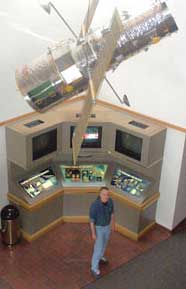The First Stars
One of the absolute best spiffs in the world, working for Space Telescope, is the monthly "popular lecture" series. They’ve had them pretty much ever since I started working there. Once a month one of the scientists at the Institute, or someone affiliated in some way with the work we do, gives a lecture targeted to a general audience, on the work they’re doing. The lectures are open to the public and all are welcome to sit in and listen, and ask questions afterward.
It’s really great getting a chance to hear the people doing this work speak for themselves, and hear firsthand the latest thinking about what makes our universe tick. Tonight’s lecture was about the very first stars to appear after the big bang and it really made me realize just how very…different…the early universe was.
It’s counter-intuitive that generating stars is hard when all you have are the vast tendrils of gaseous hydrogen in the early universe to work with. But that was the problem facing the theorists. As it turns out, getting nearly pure hydrogen gas to collapse enough to form a star isn’t easy. It doesn’t really want to. It will collapse, but then as it does it heats up slightly and wants to expand again. So it achieves a stability well below the threshold for generating a star. To go the rest of the way, the gas needs to cool by radiating off some of its heat, and that’s something it turns out hydrogen isn’t good at.
But molecular hydrogen is…and there’s the key ingredient. The random motion in a hydrogen gas structure will eventually form molecules and those will radiate heat much more easily. That will cool the structure down enough that it can collapse some more. Then it becomes a question of how big it got…and here is where the early universe shows its strangeness.
Remember…these are the first stars. They can’t be formed from the shock waves of other stars dying or coming to life, because there are no other stars yet. And all they have to work with is hydrogen gas. There are no metals yet, no elements heavier then helium, because those are formed in stars and there aren’t any stars yet. The presence of metals in the interstellar medium actually makes it easier to form stars. The way star formation works now, just doesn’t work back then. The hydrogen structure (gas cloud…whatever…) has to collapse on its own, due to its own random motion and gravity, with no assistance from any other nearby objects, because there are no other nearby objects yet. And it has to be massive…really massive…for its collapse to break through the threshold where the heat from its own collapse simply pushes it back apart again and it never forms a star. I mean…Really Massive. About one-hundred times the mass of our sun massive. Far more massive then the most massive stars that form in the cosmos as it is now. Otherwise, it simply achieves stability as a dense cloud of hydrogen gas.
But if the structure got that big when it started collapsing, and was able to keep on collapsing over time as it shrank and heated up, radiated some heat off a bit and collapsed some more, heated up again, cooled down some more, and so on…at some point it hits a threshold where the collapse suddenly runs away and then the only thing that stops it is when the gas gets so dense and hot nuclear fusion starts happening and the gravitational collapse is pushed back by that. Then what you end up with is…a star about a hundred times the mass of our sun.
Those stars are Strange. They are fantastically brilliant, live very very short lives, and are massive enough to produce carbon, and then use their own carbon to produce other metals up to iron. Some of them, in death, may have formed the massive black holes that lit the earliest quasars.
But they didn’t form galaxies. The galaxies, by the time they began to form, already existed in a cosmic medium that had been seeded by metals from the first stars. In that medium star formation was easier, resulting in much smaller, more longer lived stars.
No first stars have been observed yet. They would be too faint, and too red shifted for the instruments we currently have. The next generation space telescope (the James Webb Space Telescope) may be able to observe the first galaxies. But observing a first generation star would be possible only in its death supernova, and then only by lucky chance. But now I know better why the next generation space telescope is so focused on infrared astronomy and not visible light astronomy. They need that to see the early universe…the first galaxies…and, maybe, the first stars. All of that stuff is red shifted away from the visible light now, because of the expansion of the universe since then.
I love this job. Other jobs I’ve had the upper management has been something out of Dilbert. It’s scary how true to life Dilbert is sometimes. This one I get to hear the top floors talk about how they’re gathering light from near the beginning of time and trying to figure out what it’s telling us about the universe we live in. And I get to hear about it before it goes into the textbooks.







































